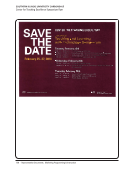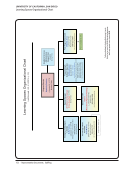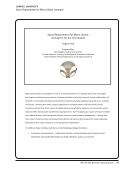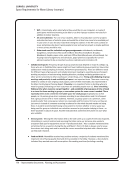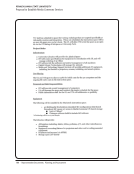SPEC Kit 342: Next-Gen Learning Spaces · 17
SURVEY QUESTIONS AND RESPONSES
The SPEC Survey on Next-Gen Learning Spaces was designed by Sherri Brown, Instruction Unit Head,
Public Services, Charlie Bennett, Undergraduate Programming and Engagement Librarian, Bruce Henson,
Associate Dean for Research and Learning Services, and Alison Valk, Multimedia Instruction Librarian, at
the Georgia Institute of Technology Library. These results are based on data submitted by 72 of the 125 ARL
member libraries (58%) by the deadline of May 14, 2014. The survey’s introductory text and questions are
reproduced below, followed by the response data and selected comments from the respondents.
Many research libraries were radically transformed in the early 2000s with the introduction of information commons. In 2004,
Leslie Haas and Jan Robertson from the University of Utah authored SPEC Kit 281, The Information Commons, which provided
an overview of the state of commons in ARL member libraries. Since that time, these commons have continued developing as the
growth of electronic resources has reduced the space necessary for physical collections. Libraries are using that newly available space
for much more than computer labs and study areas. In the last decade, what we are calling Next-Gen Learning Spaces have emerged
that bring together services, programming, instruction, campus and community collaboration, and specialized resources of all kinds
to support a wide range of teaching, learning, and research.
Next-Gen learning spaces are distinguished from information commons or other library innovations by their purpose and by
the activities libraries encourage within them. Next-Gen learning spaces are service-rich environments created in collaboration
with campus partners that support active learning and multidisciplinary instruction along with providing a platform for scholarly
communication and cultural enrichment. These spaces can be created all at once in one renovation or construction project, or they
can develop piece-by-piece, e.g., when a library adds new services to a computer lab or classroom that in turn create an opportunity
to collaborate with an external partner.
The purpose of this survey is to explore the configuration and uses of library learning spaces, the developments and transformations
that have occurred over the past ten years, and future plans for learning spaces to determine where these learning spaces are on a
continuum between first-gen information commons and next-gen spaces. The compiled responses from ARL members can be used
as a benchmark for individual libraries making decisions regarding existing and future learning spaces, as well as to form a more
complete picture of the direction in which learning spaces are headed as we move further into the 21st century.
This survey explores five main areas related to learning spaces. The first sections of the survey seek to identify what kinds of learning
spaces currently exist, how these spaces have changed since their inception, and the effects these spaces have had on other library
operations. The next three sections explore the instruction, programming, and collaboration that take place in the learning spaces.
Finally, the last section is focused on the current assessment of ARL members’ learning spaces and changes that have been made or
are planned based on the results of these evaluations.
SURVEY QUESTIONS AND RESPONSES
The SPEC Survey on Next-Gen Learning Spaces was designed by Sherri Brown, Instruction Unit Head,
Public Services, Charlie Bennett, Undergraduate Programming and Engagement Librarian, Bruce Henson,
Associate Dean for Research and Learning Services, and Alison Valk, Multimedia Instruction Librarian, at
the Georgia Institute of Technology Library. These results are based on data submitted by 72 of the 125 ARL
member libraries (58%) by the deadline of May 14, 2014. The survey’s introductory text and questions are
reproduced below, followed by the response data and selected comments from the respondents.
Many research libraries were radically transformed in the early 2000s with the introduction of information commons. In 2004,
Leslie Haas and Jan Robertson from the University of Utah authored SPEC Kit 281, The Information Commons, which provided
an overview of the state of commons in ARL member libraries. Since that time, these commons have continued developing as the
growth of electronic resources has reduced the space necessary for physical collections. Libraries are using that newly available space
for much more than computer labs and study areas. In the last decade, what we are calling Next-Gen Learning Spaces have emerged
that bring together services, programming, instruction, campus and community collaboration, and specialized resources of all kinds
to support a wide range of teaching, learning, and research.
Next-Gen learning spaces are distinguished from information commons or other library innovations by their purpose and by
the activities libraries encourage within them. Next-Gen learning spaces are service-rich environments created in collaboration
with campus partners that support active learning and multidisciplinary instruction along with providing a platform for scholarly
communication and cultural enrichment. These spaces can be created all at once in one renovation or construction project, or they
can develop piece-by-piece, e.g., when a library adds new services to a computer lab or classroom that in turn create an opportunity
to collaborate with an external partner.
The purpose of this survey is to explore the configuration and uses of library learning spaces, the developments and transformations
that have occurred over the past ten years, and future plans for learning spaces to determine where these learning spaces are on a
continuum between first-gen information commons and next-gen spaces. The compiled responses from ARL members can be used
as a benchmark for individual libraries making decisions regarding existing and future learning spaces, as well as to form a more
complete picture of the direction in which learning spaces are headed as we move further into the 21st century.
This survey explores five main areas related to learning spaces. The first sections of the survey seek to identify what kinds of learning
spaces currently exist, how these spaces have changed since their inception, and the effects these spaces have had on other library
operations. The next three sections explore the instruction, programming, and collaboration that take place in the learning spaces.
Finally, the last section is focused on the current assessment of ARL members’ learning spaces and changes that have been made or
are planned based on the results of these evaluations.










































































































































